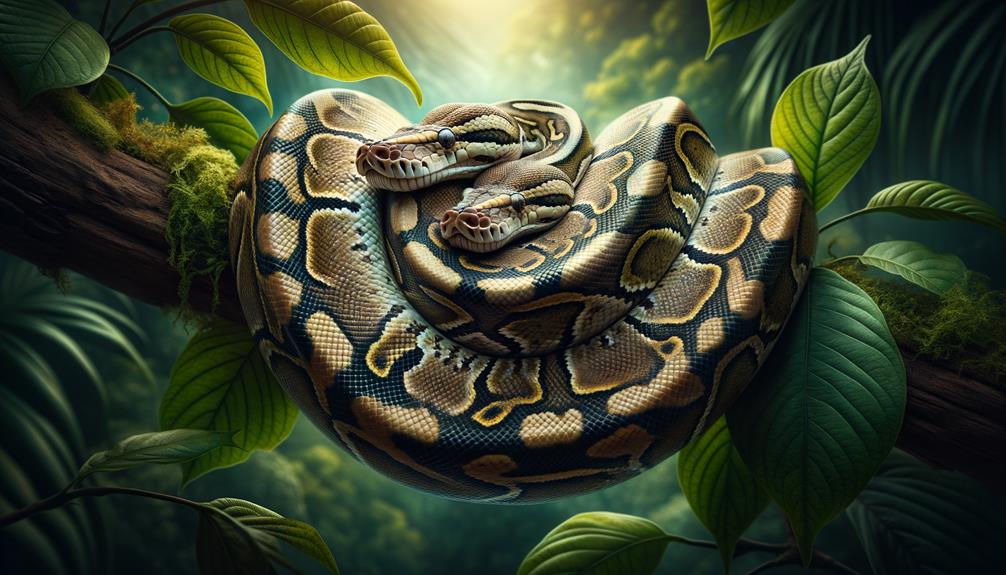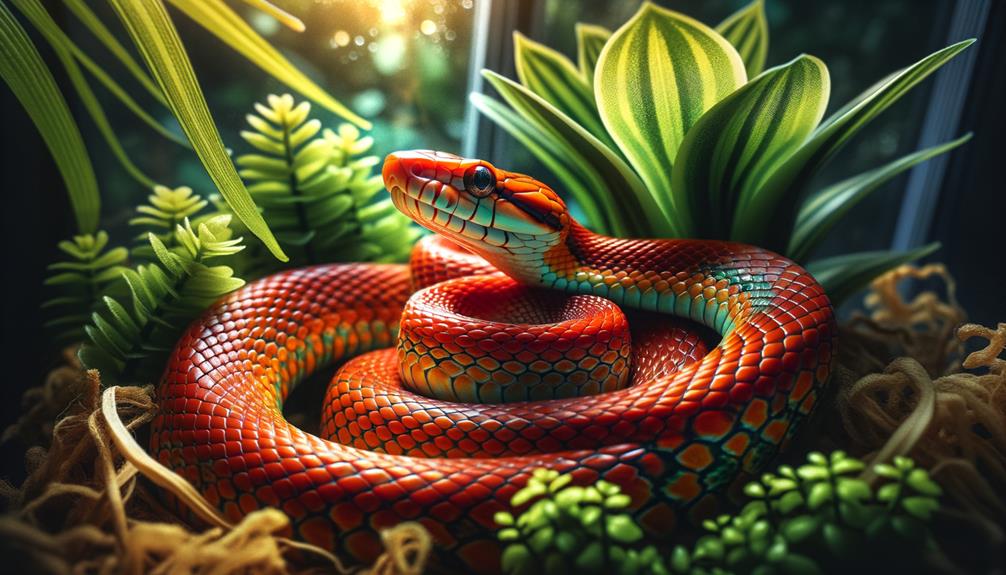Rough Green Snakes Agile Insectivores
I've had the chance to observe rough green snakes, and I'm struck by their impressive agility in both climbing and swimming. These snakes thrive in diverse habitats, ranging from Mexico to the Southeastern United States, and they're particularly at home in areas with dense vegetation near water. As insectivores, they primarily feed on insects, but they'll occasionally snack on snails and tree frogs, blending seamlessly into the green grass to hunt effectively. Their slender bodies and calm demeanor make them fascinating to watch. Despite being listed as Least Concern, they face threats from habitat loss and road mortality. There's so much more intriguing detail about their lifestyle and ecological role waiting to be explored.
Key Takeaways
Rough Green Snakes are primarily insectivores, feeding mainly on insects. They're incredibly agile, showcasing impressive climbing and swimming abilities that help them navigate their environment. Their slender bodies and green coloration provide excellent camouflage in grassy environments, allowing them to blend in seamlessly. By controlling insect populations within their habitats, they play a crucial role in maintaining the ecosystem's balance. Active during the day, they utilize their agility to hunt and evade predators with ease.
Distribution
Rough green snakes have adapted remarkably to diverse habitats, from Mexico's tropical savannas to the Southeastern United States' temperate forests. Their distribution stretches from Florida's sunny landscapes to Maine's coastal regions, and westward to Indiana and Central Texas. This wide range highlights their ability to thrive in both terrestrial and arboreal environments.
In the Southeast, these snakes often inhabit areas with dense vegetation near water sources, such as rivers, lakes, and wetlands. The lush foliage provides them with ample cover and hunting grounds teeming with insects. Their adaptability is evident as they navigate temperate broadleaf forests and tropical savannas, blending seamlessly into their surroundings.
Despite habitat loss and the pet trade, the rough green snake's stable population trend has earned it a classification of Least Concern on the IUCN Red List. It's fascinating to observe how these slender, vibrant snakes maintain their presence across such a broad and varied range. Their ability to flourish in diverse biomes underscores the resilience and adaptability inherent to their species.
Habits and Lifestyle
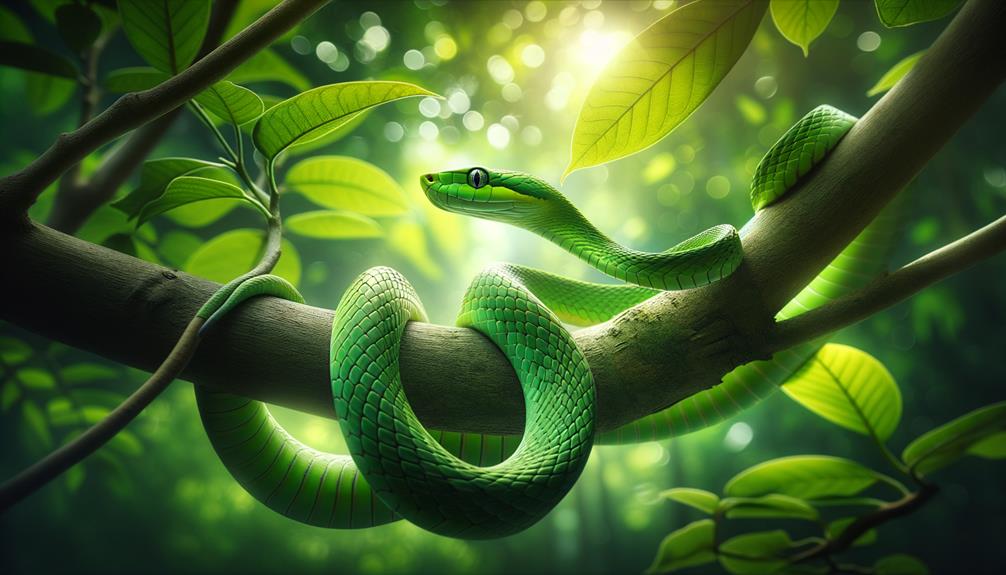
With their affinity for life in the trees, green snakes showcase impressive agility as they navigate through canopies in search of their next insect meal. Their small size and slender bodies allow them to weave through dense vegetation with ease, making them skilled at catching prey. Watching them move is like witnessing a fluid dance; they glide effortlessly from branch to branch, rarely touching the ground.
Rough green snakes are primarily active during the day, which aligns perfectly with their insectivorous diet, as many insects are also active during daylight hours. These snakes are not just skilled climbers; they're also proficient swimmers, adding to their adaptability.
Despite their remarkable hunting skills, they are peaceful creatures. They rarely show aggression, even when threatened. Instead, they rely on their camouflage and agility to evade predators. During the colder months, they retreat into hibernation, finding refuge in the safety of tree hollows or beneath leaf litter, rather than migrating. This behavior highlights their resilient yet tranquil nature, making them fascinating subjects for anyone passionate about the freedom of the wild.
Diet and Nutrition
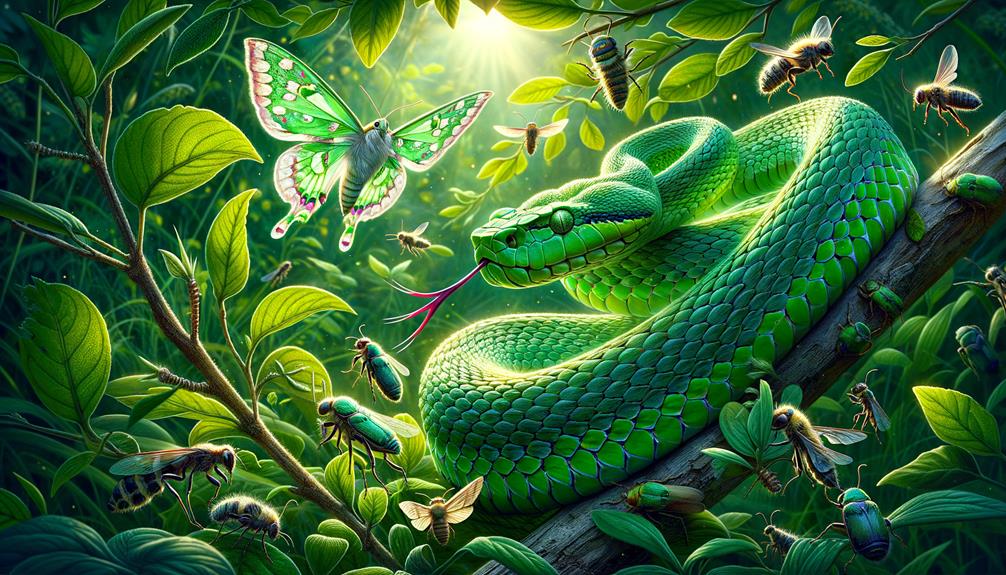
Rough green snakes are agile insectivores that primarily feed on a diverse array of insects, including grasshoppers, crickets, caterpillars, and moths. These snakes also occasionally consume snails and tree frogs, adding variety to their nutritional intake. Their slender bodies, vibrant in color, blend seamlessly with the green grass, making them adept hunters.
Here's an overview of their dietary preferences:
| Primary Diet | Occasional Diet |
|---|---|
| Grasshoppers | Snails |
| Crickets | Tree Frogs |
| Caterpillars |
In their natural habitat, I've observed how their slender, green bodies allow them to move gracefully through the foliage, effortlessly securing their prey. These snakes can eat a range of insects, displaying impressive agility and precision. Their diet is not just a matter of survival but also a reflection of their adaptability within their ecosystems.
Rough green snakes play a vital role in controlling insect populations, which in turn supports the balance of their habitat. They are more than just beautiful inhabitants of the green grass; they're essential contributors to the ecological community.
Population
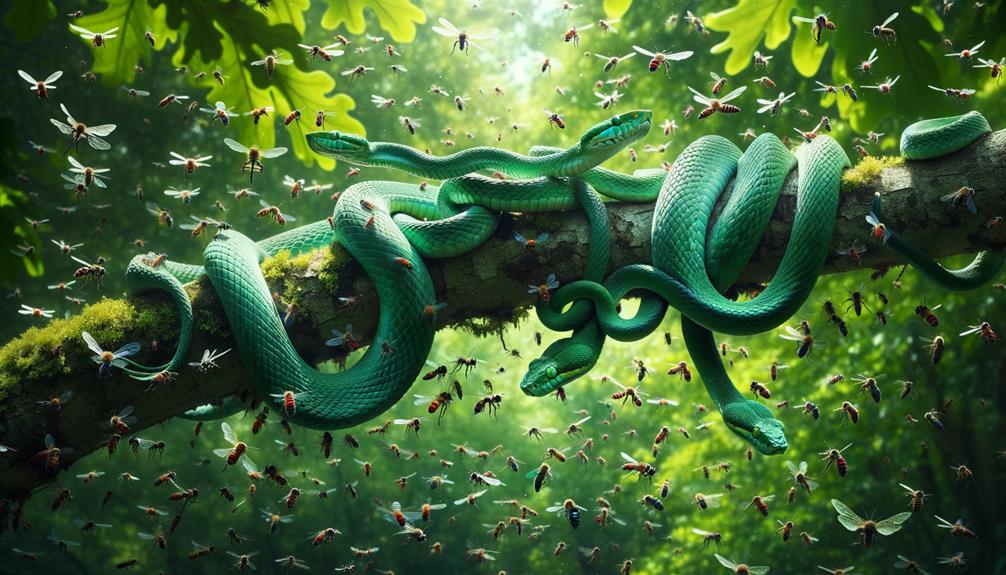
As I observe these agile insectivores thriving in their natural habitats, I'm struck by the various factors influencing their population dynamics. Rough green snakes face significant challenges, including habitat loss and road mortality, which can fragment their populations and reduce their numbers. Despite these threats, the IUCN lists them as Least Concern, suggesting a stable population trend. However, this stability is precarious.
In North America, the pet trade poses a significant threat to rough green snakes. Overcollection for the pet trade can lead to local population declines, particularly when combined with habitat destruction. Urban development and deforestation are primary culprits, stripping away the dense vegetation these snakes rely on for shelter and hunting grounds.
Road mortality further exacerbates the issue. Snakes frequently fall victim to vehicles while crossing roads, a risky journey that significantly impacts local populations. Additionally, rough green snakes are a vital food source for various predators, which naturally affects their numbers.
Their range spans from Florida to coastal Maine, Indiana, and Central Texas, highlighting their adaptability. However, without concerted conservation efforts, these resilient insectivores may face a more uncertain future.
Ecological Niche
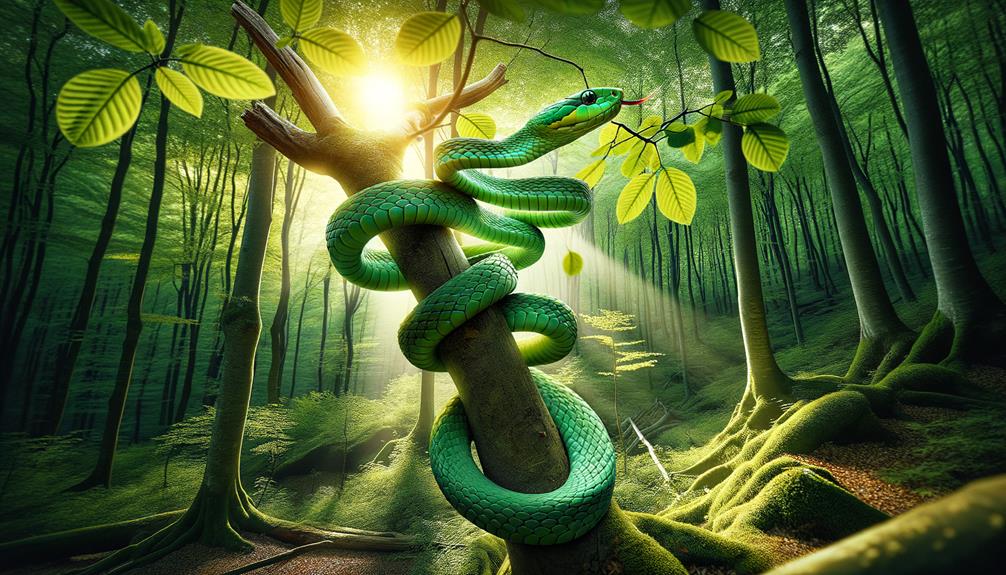
Rough green snakes play a vital role in their ecosystems as agile insectivores, meticulously regulating insect populations within their habitats. These slender serpents, scientifically known as Opheodrys aestivus, primarily feed on a variety of insects like grasshoppers, crickets, caterpillars, and spiders. Their diet showcases their remarkable adaptability and agility, enabling them to capture prey that other predators might overlook.
In their pursuit of food, rough green snakes maintain the delicate balance of their ecosystem. By controlling insect populations, they prevent any one species from dominating, which could lead to ecological imbalances. This balance is crucial for the health of their habitats, as it ensures that plant life isn't devastated by unchecked herbivorous insect populations, and it also influences the distribution of other predatory species.
The rough green snake's ecological niche highlights its significance as an insectivore. It demonstrates how even the smallest predator can have a profound impact on the environment. These snakes exemplify the interconnectedness of nature, where each species, no matter how small, contributes to the overall harmony and health of the ecosystem.
Frequently Asked Questions
Are Rough Green Snakes Insectivores?
Rough Green Snakes are indeed insectivores. In the wild, I've observed them feeding on a variety of insects, including grasshoppers, crickets, and caterpillars. Their role in maintaining ecosystem balance is vital, making them fascinating creatures to study and observe.
What Does a Rough Green Snake Eat?
Rough green snakes primarily feed on soft-bodied insects like grasshoppers, crickets, and caterpillars. They also hunt spiders, moths, and occasionally small vertebrates such as tree frogs and snails, consuming their prey whole during the day.
Are Rough Green Snakes Arboreal?
Rough green snakes are indeed arboreal, and I've witnessed them navigating through trees, bushes, and vines with remarkable agility. By living in elevated habitats, they're able to avoid predators and access insect-rich areas, showcasing their impressive adaptability.
Can Rough Green Snakes Eat Mealworms?
Rough green snakes can enjoy a diet that includes mealworms, which are rich in nutrients like protein and fat. Including mealworms in their diet helps keep these agile insectivores healthy and thriving in captivity.


